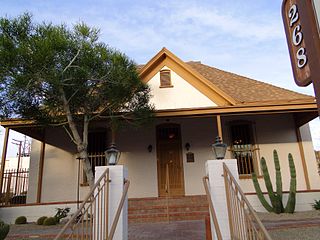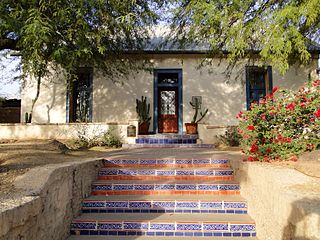
Organ Pipe Cactus National Monument is a U.S. national monument and UNESCO biosphere reserve located in extreme southern Arizona that shares a border with the Mexican state of Sonora. The park is the only place in the United States where the senita and organ pipe cactus grow wild. Along with this species, many other types of cacti and other desert flora native to the Yuma Desert section of the Sonoran Desert region grow in the park. Organ Pipe Cactus National Monument is 517 sq mi (1,340 km2) in size. In 1976 the monument was declared a Biosphere Reserve by UNESCO, and in 1977 95% of Organ Pipe Cactus was declared a wilderness area.

Fort Yuma was a fort in California located in Imperial County, across the Colorado River from Yuma, Arizona. It was on the Butterfield Overland Mail route from 1858 until 1861 and was abandoned May 16, 1883, and transferred to the Department of the Interior. The Fort Yuma Indian School and the Saint Thomas Yuma Indian Mission now occupy the site. It is one of the "associated sites" listed as Yuma Crossing and Associated Sites on the National Register of Historic Places in the Yuma Crossing National Heritage Area. In addition, it is registered as California Historical Landmark #806.

Yuma Crossing is a site in Arizona and California that is significant for its association with transportation and communication across the Colorado River. It connected New Spain and Las Californias in the Spanish Colonial period in and also during the Western expansion of the United States. Features of the Arizona side include the Yuma Quartermaster Depot and Yuma Territorial Prison. Features on the California Side include Fort Yuma, which protected the area from 1850 to 1885.

The Brown House is a 19th-century house in Yuma, Arizona, built of brick in the 1890s.

Yuma Quartermaster Depot State Historic Park, formerly Yuma Crossing State Historic Park, and now one of the Yuma Crossing and Associated Sites on the National Register of Historic Places in the Yuma Crossing National Heritage Area. It is an Arizona state park in the city of Yuma, Arizona, US.

Ortiz House in Yuma, Arizona was built in 1901. It was listed on the National Register of Historic Places in 1982.

The Southern Pacific Railroad Depot in Yuma, Arizona, was built as a Spanish Colonial Revival-style station by the Southern Pacific Railroad in 1926.

St. Paul's Episcopal Church is a historic church at 637 2nd Avenue in Yuma, Arizona, United States. It was built in 1909 and added to the National Register of Historic Places in 1982. It currently serves as a cultural center.

The Brinley Avenue Historic District is a historic district in downtown Yuma, Arizona, that runs along Madison Avenue from 1st to 3rd Streets and along Second Street from Main Street to 1st Avenue. The district connected Yuma's historic commercial center along Main Street with its government center on 2nd Avenue and was actively developed from 1900 to 1925. The district was added to the National Register of Historic Places in 1982 and is also included in the larger Yuma Crossing National Heritage Area.
Norman Foote Marsh (1871-1955) was an American architect based in Los Angeles, California who worked mostly in California and Arizona.

The San Carlos Hotel is a historic hotel in Yuma, Arizona. Its construction cost $300,000, and it was completed in 1930. It was five stories high, with 107 bedrooms. It was remodelled into 59 residential apartments in the 1980s.
Gustav A. Hanssen was an American architect. He designed private residences in Davenport, Iowa and later moved to San Diego, California. Several of his buildings are listed on the National Register of Historic Places (NRHP).

The Mexican Consulate is a historic adobe house in Yuma, Arizona. It was built circa 1892 for Dionicio Sanchez and his wife, Mary. In 1897, it was purchased by John Stoffela, who rented it to Henry M. Gandolfo, the Mexican consul, in the 1900s. The house houses the Mexican consulate in Yuma while Gandolfo resided here. It remained in the Stoffela family until 1978. It has been listed on the National Register of Historic Places since December 7, 1982.

The Ruth Ewing House is a historic concrete block cottage in Yuma, Arizona, with a hipped roof. It was built in 1906 for Ruth Ewing, a parishioner of the St. Paul's Episcopal Church. Ewing bequeathed the house to the church, and it was later purchased by Reverend R. W. Dixon. It has been listed on the National Register of Historic Places since December 7, 1982.

The Balsz House is a historic adobe house in Yuma, Arizona. It was built in 1899 by Harry Neahr, and it belonged to the Balsz family from 1919 to 1976. The Balszes worked in the meat industry. The house is "a well preserved example of middle class housing in Yuma at the turn of the century." It has been listed on the National Register of Historic Places since December 7, 1982.

The Brownstetter House is a historic house in Yuma, Arizona. It was built in 1909. From 1912 to 1949, it belonged to Harry Brownstetter, "a successful merchant, real estate developer, and financier." The house was designed in the American Craftsman and the Victorian architectural styles.

The Caruthers House is a historic house in Yuma, Arizona. It was built in 1895 for F. B. Logan and was extensively remodeled in 1906. It was purchased by C. E. Eichelberger in 1900, and by E. G. Caruthers in 1906. The latter was a banker. The house was designed in the American Craftsman architectural style. It has been listed on the National Register of Historic Places since December 7, 1982.

The Jerry Kent House is a historic house in Yuma, Arizona. It was built in 1905 for Jennie Kent, a schoolteacher. It was purchased by J. P. Yemen, a dentist, in 1920. The house was designed in the Classical Revival architectural style. It has been listed on the National Register of Historic Places since December 7, 1982.
















